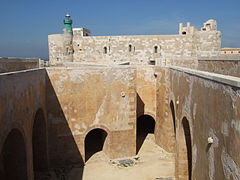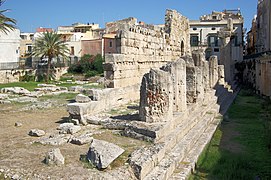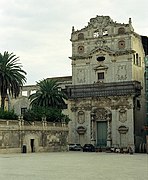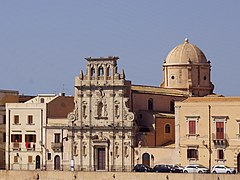Ortygia (Syracuse)
Ortygia ( Italian Ortigia ; Greek Ὀρτυγία ) is the name of a small island off the east coast of Sicily , which forms the historic center of the city of Syracuse and is only separated from the mainland by a passage a few meters wide. It covers an area of almost one square kilometer and has around 4,500 inhabitants. The limestone island closes the bay, which forms the natural harbor of the city, to the northwest and is now connected by two bridges with the main Sicilian island and the rest of Syracuse. There is also a small port at the northern end of the island, facing the Ionian Sea .
The Greek name of the island ( ancient Greek Ὀρτυγία 'quail island' , to ὄρτυξ ortyx , German 'quail' ) is an epithet of the goddess Artemis , who was supposed to be born on an island of this name. Most of the time the island of Delos has been identified as this place. Pausanias describes the Sicilian island as the mythical refuge of the nymph Arethusa , who has turned into a spring here. This spring is still shown today as Fonte Aretusa in a fountain built in 1847.
history
The first sparse evidence of human settlement in Ortygia, which came to light under the Piazza del Duomo, may still date from the Neolithic . These are some fragments and tools made of obsidian , as well as a ceramic fragment of a vessel of closed form discovered at the nearby Palazzo Beneventano del Bosco. More and more definitely dated material comes from the early Bronze Age and is attributable to the Castelluccio culture (approx. 2200–1500 BC). Finds from the Middle Bronze Age , including the remains of round huts from the 14th century BC, show close connections to the Thapsos culture (approx. 1450–1270 BC), which is named after the place where Thapsos was found . The middle of the eighth century BC Colonization by Greeks , presumably from Corinth , which followed after BC , was not associated with violence, if one believes the account of Thucydides , according to which the original Sicilian inhabitants left the island at the time of the Greek colonization and retreated into the Sicilian interior. The favorable location of the place promoted the rise of Syracuse to the dominant colony of the Sicilian east coast: Due to the island location, the place was considered safe, the presence of springs guaranteed the drinking water supply, and the bay made it possible to build a safe harbor. Already in ancient times the city was connected to the Sicilian coast by a dam.
Ortygia already played the role of the political and administrative center of Syracuse in Greek times, which it retained in the further history of the city . On the island there were residences of the rulers of the city, such as Dionysius I and Hieron II.
From the Middle Ages to the 19th century, the island was surrounded by mighty walls that made it a heavily fortified fortress.
In the second half of the 20th century, the resident population began to move away from the island, accompanied by an increase in crime and some decline. However, a number of urban projects succeeded in re- urbanization through restoration work and the establishment of tourist infrastructures such as hotels and a museum. Ortygia has been a listed building since 1976 by a law of the Sicilian regional assembly.
Ortygia district
Ortygia is divided into the following small historical quarters:
- Graziella ( siz. Razziedda )
- Bottari (Ùttari)
- Mastrarua (Masciarrò)
- Spirduta (Spidduta)
- Maestranza (Mascianza)
- Duomo (Domu)
- Giudecca (Jureca)
- Turba (Tubba)
- Castello Maniace (Casteddu)
Main sights
- Castello Maniace (1232-1240)
- Temple of Apollo (6th century BC)
- Cathedral (7th century, facade 1728)
- Museo Regionale di Palazzo Bellomo
- Artemis Fountain (1906)
- Porta Urbica (6th / 5th century BC)
- Palazzo del Vermexio, seat of the city administration (1628–1632)
- San Martino Church
- Santa Lucia alla Badia church
- Spirito Santo Church
- Palazzo Beneventano del Bosco (1779–1788)
- Palazzo Mergulese-Montalto
gallery
Web links
- Page about Ortigia (ital.)
- Website of the project "Underground Ortygia" (ital.)
Individual evidence
- ↑ pause. 5.7.2 and pause . 8.54.3 (English translation)
- ↑ Anita Crispino: Materiali dall'età Preistorica all'età ellenistica. in: Giuseppe Voza (ed.): Siracusa 1999. Lo scavo archeologico di Piazza Doumo. , Lombardi, Palermo 1999, p. 21.
- ↑ Anita Crispino: Materiali dall'età Preistorica all'età ellenistica. in: Giuseppe Voza (ed.): Siracusa 1999. Lo scavo archeologico di Piazza Doumo. , Lombardi, Palermo 1999, p. 21 and illustrations p. 22.
- ↑ Law of the Region of Sicily for the Protection of the Island (ital.)
Coordinates: 37 ° 3 ′ 40 ″ N , 15 ° 17 ′ 39 ″ E
















